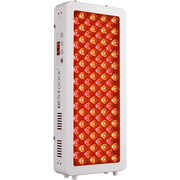Introduction
Competitive rowing, indeed, is a tough environment where high physical demands tend to inflict chronic pain and overuse injuries on most athletes. The repetitive movements of rowing, especially on the upper body, make it pretty much unbearable on muscles, joints, and tendons. In answer to such problems, there has been an increasing trend in the use of novel treatments such as red light therapy (RLT) for fast-tracking recovery and treatment of pain among athletes and coaches.
Using low-wavelength red light to penetrate into tissues and stimulate a process that heals is slowly becoming recognized as a new way for treating injuries and optimizing recovery non-invasively. This blog post investigates how red light therapy is transforming the management of injuries in rowers as an alternative to rest, ice, medication, and other inefficient treatments.
Overuse injuries are common in rowers, as the activity is recurring with high intensities that, overtime, wear down muscles and joints. The most frequent rowing injuries of lower back pain, shoulder impingement, and tendonitis bring performance down considerably both at training and on the field of competition.

How Red Light Works to Heal Your Body
Special Light Waves Help Your Cells Work Better
Red Light Therapy uses some specific wavelengths of light, usually between 600 and 660 nanometers (red light) and 850-940 nanometers (NIR), which penetrate the skin and cause stimulation of cellular processes deep in tissues. When the light wavelengths reach a cell, they energize the mitochondria, which are the energy-producing structures found in cells. This action enhances ATP production, which increases energy availability to damaged tissues and accelerates the healing process.
Red Light Helps Your Body in Three Ways
Besides promoting cellular repair, RLT has been shown in numerous studies to decrease inflammation, improve circulation, and increase collagen production. Those will be very helpful benefits in the process of pain reduction and fast recovery—especially for athletes prone to repetitive strain injuries.
Treatment Sessions: When and How Long
It is important that the right parameters—wavelength, intensity, and duration—are used so that RLT is most effective and tailored to the specific injury. In general, chronic pain is treated at lower intensities, while higher intensities are used for acute injuries. In rowers, where there is an overlap of chronic and acute issues, the balance of these parameters provides for effective treatment.
A typical RLT session for injury recovery will normally vary between 15 and 30 minutes, depending on the intensity of the injury and the device being used. It is usually performed 3–5 times a week, with the primary intention of reduction as the injury heals.
Studies Show Red Light Really Works
Numerous studies have supported the use of RLT in sports medicine, particularly due to musculoskeletal injuries. The research presents findings indicating that RLT reduces pain, decreases muscle inflammation, and increases the healing rates of soft tissues. Other studies recommend RLT as an adjunct to other traditional therapies such as physical therapy, massage, and stretching; better results are revealed with a reduction in recovery time.
Common Rowing Injuries and How Red Light Therapy Helps
Lower Back Pain and Muscular Strains
Lower back pain is one of the most frequent complaints heard by rowers. The repeated action of the rowing stroke can put a strain on the lower back muscles and spine, especially if added to this poor posture or an athlete's poor technique. RLT helps to reduce inflammation and muscle spasms that can develop with lower back pain through increasing blood flow and promotion of healing of muscle fibers.
Shoulder Impingement and Rotator Cuff Tendinitis
The shoulders are heavily involved in rowing and thus will be prone to overuse injuries, which include shoulder impingement and rotator cuff tendinitis. RLT stimulates collagen production and enables tissue regeneration; thus, the tendons and ligaments of the shoulder will improve in strength. This also reduces inflammation and pain, allowing rowers to continue training while healing.
Rib Stress Fractures and Costovertebral Joint Dysfunction
Such heavy-force application with every stroke may cause rib stress fractures or costovertebral joint dysfunction, resulting in very sharp pain in the chest and back. Red light therapy can help to speed up bone healing and reduce inflammation from these types of injuries, meaning less downtime.
Knee Pain, Including Patellofemoral Syndrome and Iliotibial Band Friction Syndrome
The repetitive bending and straightening of the legs can make knee pain common among rowers. RLT can be applied to the knee joints to reduce inflammation and promote the healing of tissues damaged by diseases such as patellofemoral syndrome or iliotibial band friction syndrome. RLT improves circulation and thus reinforces tissue repair to reduce the need for extended rest periods, which accelerates recovery.
Wrist Tendonitis and Carpal Tunnel Syndrome
Such problems are frequently seen in rowers who keep their grip tight for longer periods. In such kinds of wrist injuries, red-light treatment can be applied to the wrist area to relieve pain and enhance healing via inflammation reduction and regeneration of damaged tissues.
| Injury | What Causes It | How Red Light Therapy Helps |
| Lower Back Pain | Repetitive rowing motions strain back muscles, especially with poor form |
• Boosts blood flow to reduce swelling • Relaxes tight muscles • Speeds up muscle repair |
| Shoulder Problems | Heavy shoulder use leads to pinched nerves and tender rotator cuffs |
• Builds stronger connective tissue • Eases pain and swelling • Lets you keep training while healing |
| Rib Injuries | Strong rowing forces can strain or crack ribs |
• Helps bones heal faster • Calms inflammation • Gets you back to rowing sooner |
| Knee Pain | Constant leg bending puts stress on knee joints |
• Reduces joint swelling • Repairs worn tissue • Improves blood flow • Shortens recovery time |
| Wrist Pain | Gripping oars too tightly for too long |
• Stops pain quickly • Reduces swelling • Repairs damaged tissue • Strengthens wrist over time |
How to Make Red Light Therapy Part of Your Rowing Routine
Best Practices for Incorporating RLT into Rowing Routines
Rowers needs to integrate RLT with other recovery methods to use it optimally for their rowing schedule. One way through which RLT helps is post-intervention after a race or intense near-simulative practice: muscle soreness and inflammation will be scarce. RLT can also be incorporated into the warmup for pre-training to get the blood and muscles ready for activities.
How Often and How Long Should RLT Sessions Be for Maximum Benefit?
While each rower's requirements are distinct, stipulations for the RLT approach should be set at two to three sessions held weekly for 10 to 20 min each and adapted according to need, as frequency differs according to the severity of the injury and the rower's progress.
How to Choose the Right RLT Devices for Optimal Results
The most important thing is to choose the right device in order to achieve desired results. Rowers can look for devices that offer the right wavelength (600-660 nm red light and 850-940 nm NIR) and enough power output to penetrate sufficiently into tissues. Handheld or full-body units can offer controlled therapy and use depending on the size and location of the injury.

How to Make Red Light Therapy Work Better for You
Using Better Rowing Form Helps the Treatment Work
RLT itself is a very powerful tool for recovery; however, injury prevention should also take into account additional practices. Rowers should be polishing their technique and biomechanics to prevent injuries. RLT may have a role in tripling-up recovery as an acute factor in healing, but it works best with intelligent training.
Add Strength and Stretching to Stay Injury-Free
Focus on exercises that target common rowing weak spots: your core, lower back, and shoulders. Try planks and bird dogs to build core strength, rowing-specific stretches for flexibility, and lightweight resistance training for shoulder stability. Aim for 2-3 strength sessions per week, and always warm up with dynamic stretches before rowing. When you combine these exercises with red light therapy after workouts, you'll recover faster and build stronger muscles.
Rest Smart to Feel Better
Your body needs real breaks between training sessions - at least one full rest day per week. Use these days for gentle movement like walking or light stretching, and schedule your red light therapy sessions then too. The ideal timing is 20-30 minutes of red light treatment when your muscles are relaxed. This helps your body repair tissue damage while you rest, so you're ready for your next workout.
How Does RLT Work with Other Recovery Methods Like Cryotherapy, Massage, and Stretching?
Incorporating red light therapy with other recovery modalities such as cryotherapy, massage, and stretching would lead to synergistic benefits: faster recovery periods and increased performance.
The Future of Red Light Therapy in Rowing
Getting Rowing Groups Into Red Light Therapy
With increased awareness of the RLT advantages, more and more rowers and coaches will begin to adopt it. Propaganda and education will be needed more than ever to disseminate this welfare-cum-treatment modality, especially within such an injury-prone sport.
Boosting Research on RLT for Rowers' Health
Currently, the efficacy of RLT has been established in sports medicine, but further studies about rowing injuries will refine the prescriptions as well as advance the general know-how of how RLT can be used to benefit rowers.
Helping Rowers and Coaches Use RLT for Stronger Muscles
Rowers and coaches should be enabled to take knowledge and tools to incorporate RLT in their training and recovery programs, thereby increasing musculoskeletal health, injury risk reduction, and optimal performance over time.
Try Red Light Therapy and Row Pain-Free
Rowing can really take a toll on your body, but red light therapy is changing the game for athletes who want to train hard and recover faster. Forget about dealing with nagging injuries and long recovery times - this treatment could be exactly what you need to stay healthy on the water. When you combine red light therapy with proper training and rest, you'll notice the difference in how your body feels and performs. Whether you're hitting the water every day or coaching from the dock, why not give your body the extra support it needs? Red light therapy might just be the missing piece in your training routine to keep you rowing strong and feeling your best.
References
- Glass GE. Photobiomodulation: The Clinical Applications of Low-Level Light Therapy. Aesthet Surg J. 2021 May 18;41(6):723-738. doi: 10.1093/asj/sjab025. Erratum in: Aesthet Surg J. 2022 Apr 12;42(5):566. https://pubmed.ncbi.nlm.nih.gov/33471046/
- Borges LS, Cerqueira MS, dos Santos Rocha JA, Conrado LA, Machado M, Pereira R, Pinto Neto O. Light-emitting diode phototherapy improves muscle recovery after a damaging exercise. Lasers Med Sci. 2014 May;29(3):1139-44. https://link.springer.com/article/10.1007/s10103-013-1486-z
- Foley J, Vasily DB, Bradle J, Rudio C, Calderhead RG. 830 nm light-emitting diode (led) phototherapy significantly reduced return-to-play in injured university athletes: a pilot study. Laser Ther. 2016 Mar 31;25(1):35-42. https://pmc.ncbi.nlm.nih.gov/articles/PMC4846838/














 Small
Small

 Moderate
Moderate

 Moderate
Moderate

 Moderate
Moderate

 Full
Full



